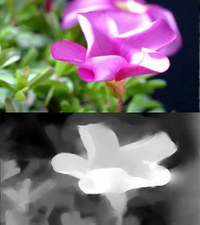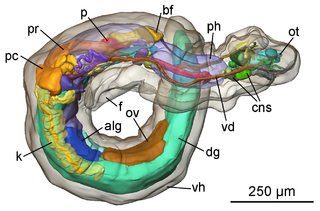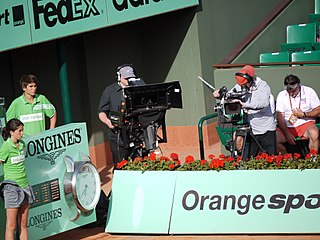Quality semiautomatic conversion
Depth-based conversion
Most semiautomatic methods of stereo conversion use depth maps and depth-image-based rendering. [4] [5]
The idea is that a separate auxiliary picture known as the "depth map" is created for each frame or for a series of homogenous frames to indicate depths of objects present in the scene. The depth map is a separate grayscale image having the same dimensions as the original 2D image, with various shades of gray to indicate the depth of every part of the frame. While depth mapping can produce a fairly potent illusion of 3D objects in the video, it inherently does not support semi-transparent objects or areas, nor does it represent occluded surfaces; to emphasize this limitation, depth-based 3D representations are often explicitly referred to as 2.5D. [6] [7] These and other similar issues should be dealt with via a separate method. [6] [8] [9]


The major steps of depth-based conversion methods are:
- Depth budget allocation – how much total depth in the scene and where the screen plane will be.
- Image segmentation, creation of mattes or masks, usually by rotoscoping. Each important surface should be isolated. The level of detail depends on the required conversion quality and budget.
- Depth map creation. Each isolated surface should be assigned a depth map. The separate depth maps should be composed into a scene depth map. This is an iterative process requiring adjustment of objects, shapes, depth, and visualization of intermediate results in stereo. Depth micro-relief, 3D shape is added to most important surfaces to prevent the "cardboard" effect when stereo imagery looks like a combination of flat images just set at different depths.
- Stereo generation based on 2D+Depth with any supplemental information like clean plates, restored background, transparency maps, etc. When the process is complete, a left and right image will have been created. Usually the original 2D image is treated as the center image, so that two stereo views are generated. However, some methods propose to use the original image as one eye's image and to generate only the other eye's image to minimize the conversion cost. [4] During stereo generation, pixels of the original image are shifted to the left or to the right depending on depth map, maximum selected parallax, and screen surface position.
- Reconstruction and painting of any uncovered areas not filled by the stereo generator.
Stereo can be presented in any format for preview purposes, including anaglyph.
Time-consuming steps are image segmentation/rotoscoping, depth map creation and uncovered area filling. The latter is especially important for the highest quality conversion.
There are various automation techniques for depth map creation and background reconstruction. For example, automatic depth estimation can be used to generate initial depth maps for certain frames and shots. [11]
People engaged in such work may be called depth artists. [12]
Multi-layering
A development on depth mapping, multi-layering works around the limitations of depth mapping by introducing several layers of grayscale depth masks to implement limited semi-transparency. Similar to a simple technique, [13] multi-layering involves applying a depth map to more than one "slice" of the flat image, resulting in a much better approximation of depth and protrusion. The more layers are processed separately per frame, the higher the quality of 3D illusion tends to be.
Other approaches
3D reconstruction and re-projection may be used for stereo conversion. It involves scene 3D model creation, extraction of original image surfaces as textures for 3D objects and, finally, rendering the 3D scene from two virtual cameras to acquire stereo video. The approach works well enough in case of scenes with static rigid objects like urban shots with buildings, interior shots, but has problems with non-rigid bodies and soft fuzzy edges. [3]
Another method is to set up both left and right virtual cameras, both offset from the original camera but splitting the offset difference, then painting out occlusion edges of isolated objects and characters. Essentially clean-plating several background, mid ground and foreground elements.
Binocular disparity can also be derived from simple geometry. [14]










